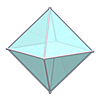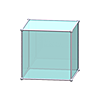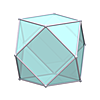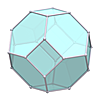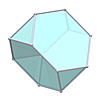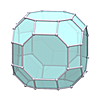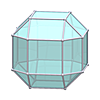|
Site Search
If you found the information useful, consider to make a donation:
| |
written by Rene K. Mueller, Copyright (c) 2007, last updated Wed, January 9, 2008
Waterman polyhedra exist in mathematics since about 1990, a rather recent discovery.
The concept of Waterman polyhedra was developed by Steve Waterman  and relate to "Cubic Close Packing" (CCP) of spheres,
also known as IVM (Isotropic Vector Matrix) by R. Buckminster Fuller.
Spheres are packed in a cubic manner:
- x, y and z are integers,
- sphere diameter is √2 thereby,
- at 0,0,0 resides the first sphere,
and then those removed which have longer vector than √(2*n) from the center (0,0,0) and then a convex hull is calculated which gives a polyhedron:
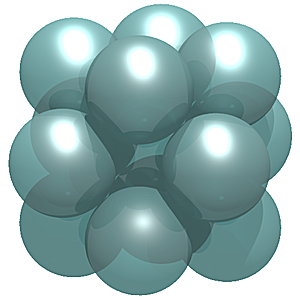 Waterman W1 O1 (radius √2)
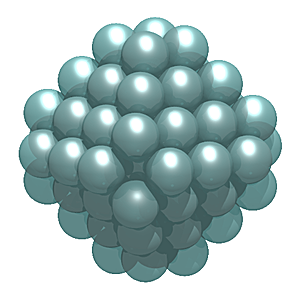 Waterman W5 O1 (radius √10)
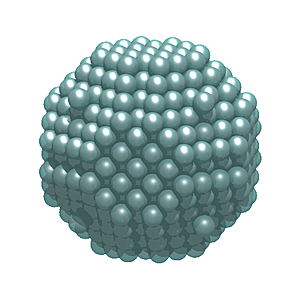 Waterman W24 O1 (radius √48)
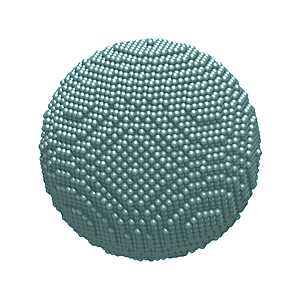 Waterman W200 O1 (radius √400)
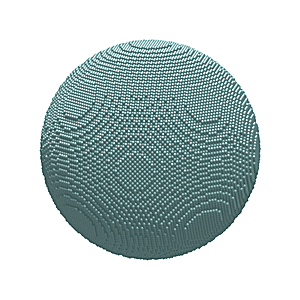 Waterman W1000 O1 (radius √2000)
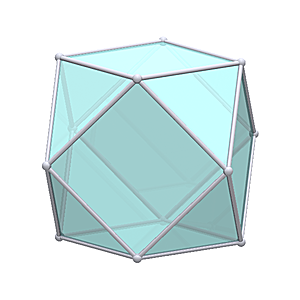 Waterman W1 O1
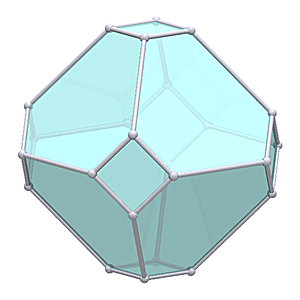 Waterman W5 O1
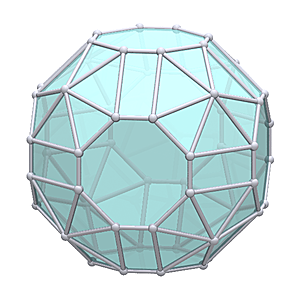 Waterman W24 O1
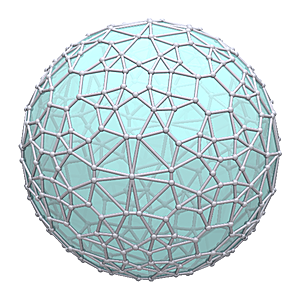 Waterman W200 O1
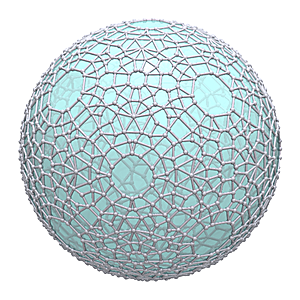 Waterman W1000 O1
Several origins are available as summarized by Mirek Majewski  : :
| Origin |
Origin Location |
radius |
Comment |
| 1 |
0,0,0 |
√(2*n) |
Atom center: traditional origin of Waterman polyhedra, symmetry properties of a cube. |
| 2 |
1/2,1/2,0 |
√(2+4*n)/2 |
Touch point between 2 atoms: symmetry properties of flat rectangle whose top & bottom faces are the same |
| 3 |
1/3,1/3,2/3 |
√(6*(n+1))/3 |
Void center between 3 atoms: symmetry properties of flat triangle whose top & bottom faces are different |
| 3* |
1/3,1/3,1/3 |
√(3+6*n)/3 |
Void center between 3 lattice voids: same symmetry of origin 3. |
| 4 |
1/2,1/2,1/2 |
√(3+8*(n-1))/2 |
Tretrahedron void center between 4 atoms: symmetry properties of a tetrahedron. |
| 5 |
0,0,1/2 |
√(1+4*n)/2 |
5 atoms: symmetry properties of a flat rectangle whose top & bottom are different. |
| 6 |
1,0,0 |
√(1+2*(n-1)) |
Octahedral void center between 6 atoms: symmetry properties of a cube. |
7 Origins of Waterman Polyhedra by Mark Newbold  |
whereas n starts with 1 for all origins.
| | O1 | O2 | O3 | O3* | O4 | O5 | O6 |
| W1 |  |  |  |  |  |  |  |
| W2 |  |  |  |  |  |  |  |
| W3 |  |  |  |  |  |  |  |
| W4 |  |  |  |  |  |  |  |
| W5 |  |  |  |  |  |  |  |
| W6 |  |  |  |  |  |  |  |
| W7 |  |  |  |  |  |  |  |
| W8 |  |  |  |  |  |  |  |
| W9 |  |  |  |  |  |  |  |
| W10 |  |  |  |  |  |  |  |
So the nice thing is, the creation of the polyhedra is done parametrically, in other words, systematically.
Needless to say, there are infinite of Waterman polyhedra, and interestingly there are doubles to be encountered, where:
- the same amount of packed spheres result in the same polyhedra (14 + 16 n) m2 (whereas n & m integers >= 0)
- the final polyhedra from packed spheres result in a previous discovered polyhedra when normalized (e.g. W3 O1 = W24 O1)
Those are not yet removed in the overview which follows.
The Waterman Polyhedra (WP) covers also some of the platonic and archimedean solids.
For sake of this comparison the WP are normalized, as W2 O1 has a different size/volume than W1 O6, but the same form of a Octahedron.
Icosahedron and Dodecahedron have no WP representation.
The following look like archimedean solids, but they are not:
as they are not having one length of edge, but two lengths of edges.
The others have no WP representation.
The Generalized Waterman Polyhedra (GWP) are currently still sorted by Steve Waterman, and I will include them later as they may cover more platonic and archimedean solids.
- Waterman Polyhedron
 , very informative site by Steve Waterman, the inventor of the Waterman polyhedra , very informative site by Steve Waterman, the inventor of the Waterman polyhedra
- Paul Bourke
 has also a comprehensive website (I highly recommend to visit), his waterman.c has also a comprehensive website (I highly recommend to visit), his waterman.c  I used to calculate those rendered Waterman polyhedra. I used to calculate those rendered Waterman polyhedra.
- 3D Junkyard
 , vast & interesting collection of links by David Eppstein , vast & interesting collection of links by David Eppstein
(End of Article)Content: - Page 1: Introduction, Platonic Solids, Archimedean Solids, Tetrahedron, Truncated Tetrahedron, Octahedron ...
- Page 2: Johnson Solids
- Page 3: Square Pyramid, Historic Pyramids, Pentagonal Pyramid, Triangular Cupola, Square Cupola, Pentagonal Cupola ...
- Page 4: Gyroelongated Pentagonal Rotunda, Gyrobifastigium, Triangular Orthobicupola, Square Orthobicupola ...
- Page 5: Augmented Triangular Prism, Biaugmented Triangular Prism, Triaugmented Triangular Prism ...
- Page 6: Parabigyrate Rhombicosidodecahedron, Metabigyrate Rhombicosidodecahedron, Trigyrate Rhombicosidodecahedron ...
- Page 7: Uniform Polyhedra, References
- Page 8: Waterman Polyhedra, Some More Examples, Different Origins, Features of Waterman Polyhedra ...
|

 and relate to "Cubic Close Packing" (CCP) of spheres,
also known as IVM (Isotropic Vector Matrix) by R. Buckminster Fuller.
and relate to "Cubic Close Packing" (CCP) of spheres,
also known as IVM (Isotropic Vector Matrix) by R. Buckminster Fuller.























































































